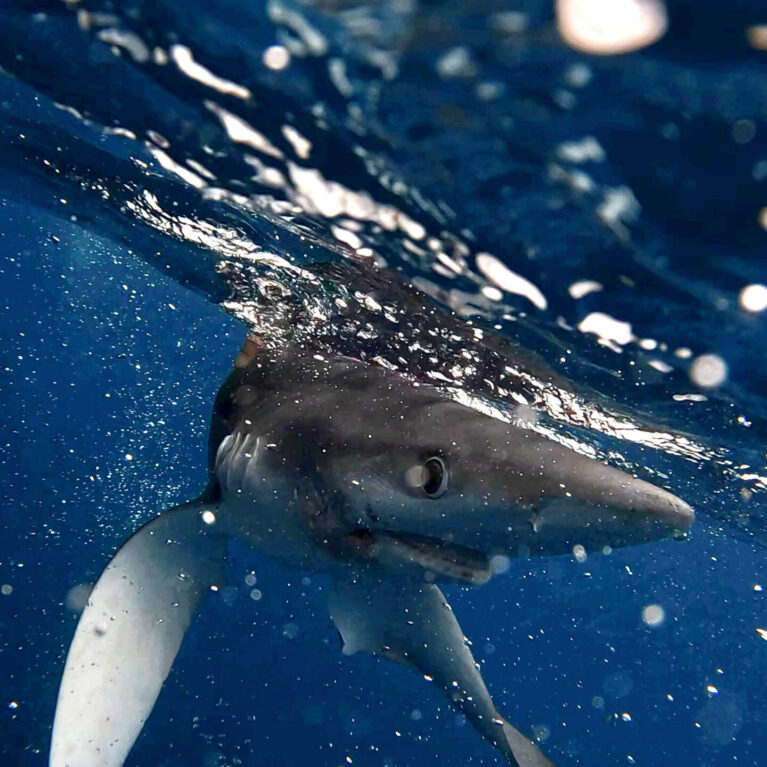Essential habitats for smooth hammerheads
Miguel is mapping potential nursery habitats for smooth hammerhead sharks in southern Portugal. He will be using the latest in telemetry technology to track their movement patterns, hoping to confirm preliminary suggestions and anecdotes from fishers that the Sagres coast in southern Portugal might provide refuge for smooth hammerhead pups to be born and grow larger and stronger before moving out into the open ocean. Miguel will be describing their migratory pathways and depth and temperature preferences and turning his information into digital multimedia content to increase awareness about the species.
Having been born and raised in Portugal, a country flanked by the Atlantic Ocean and with a biodiverse shoreline, I was always intrinsically connected to the marine environment. It was more than an interest; I felt a deep connection and a sense of awe every time I stepped into the ocean. This connection continued to evolve as I started free-diving and delving into the world of underwater photography. After that, I was certain that I wanted to pursue a career focusing on ecological research and marine conservation. Consequently, after graduating in biology at the University of Porto,...
Smooth(ing) hammerhead declines: searching for essential habitats of Sphyrna zygaena in the Algarve coast
To conduct a pilot study to identify and map essential habitats for smooth hammerhead sharks along the southern coast of Portugal.
Shark conservation efforts have been impaired by a widespread lack of knowledge about their spatial ecology. This is particularly evident in coastal areas where the pressure of human activity is great and where important shark nursery areas are believed to be located. A combination of advanced biotelemetry and biologging techniques gives us an unparalleled opportunity to identify the possible nursery sites of smooth hammerhead sharks along the southern coast of Portugal and to help inform future management action.
Sharks are key top predators in marine ecosystems, yet many shark populations are in rapid decline worldwide. As they are heavily impacted by fisheries, there is an emerging consensus on the urgent need to improve shark management strategies. However, such efforts are critically impaired by a lack of data on their ecology, especially with regard to important habitats, such as nursery grounds and sites of mating aggregations. Indeed, many coastal sharks frequently show high site fidelity or philopatry, returning to the same natal grounds to lay eggs or give birth to pups. The smooth hammerhead Sphyrna zygaena, a large, cosmopolitan shark, is believed to exhibit a similar behavioural pattern, with adults giving birth in coastal nurseries where juveniles grow until they are large enough to become oceanic. Indeed, we recently found evidence of specific coastal areas in the Azores being inhabited by juvenile smooth hammerheads for periods of up to four years, providing strong evidence for these habitats to be considered a nursery and opening the door for explicit spatial management. Yet there is still a great deal of uncertainty regarding the spatial and temporal location of these important habitats in other regions throughout the species’ distribution. Preliminary assessments, based on opportunistic observations and anecdotal evidence from local fishermen, suggest that the Sagres coast in southern Portugal may harbour such habitats. Consequently, in the present (preliminary) project we aim to use advanced telemetry techniques to investigate the movements of adult and juvenile individuals in the area and try to answer some of the long-standing questions about their spatial ecology.
- To identify and map potential S. zygaena nursery habitats in southern Portugal.
- To describe shark migratory pathways and quantify other aspects of their spatial ecology, such as depth and temperature preferences.
- To create digital multimedia content to increase societal and stakeholder engagement in marine conservation.


